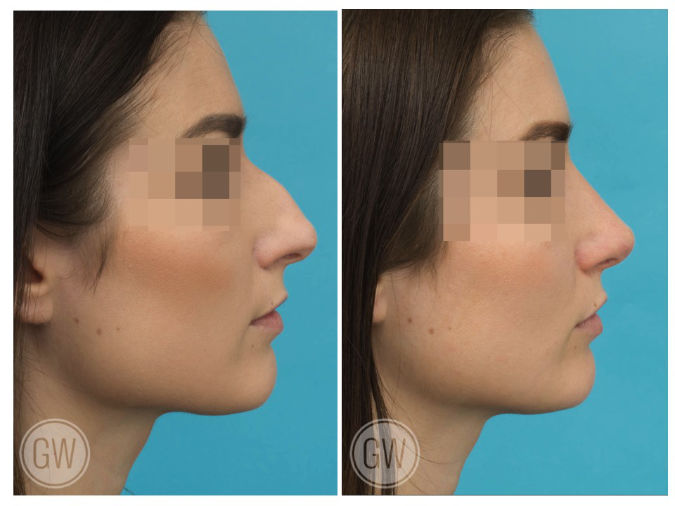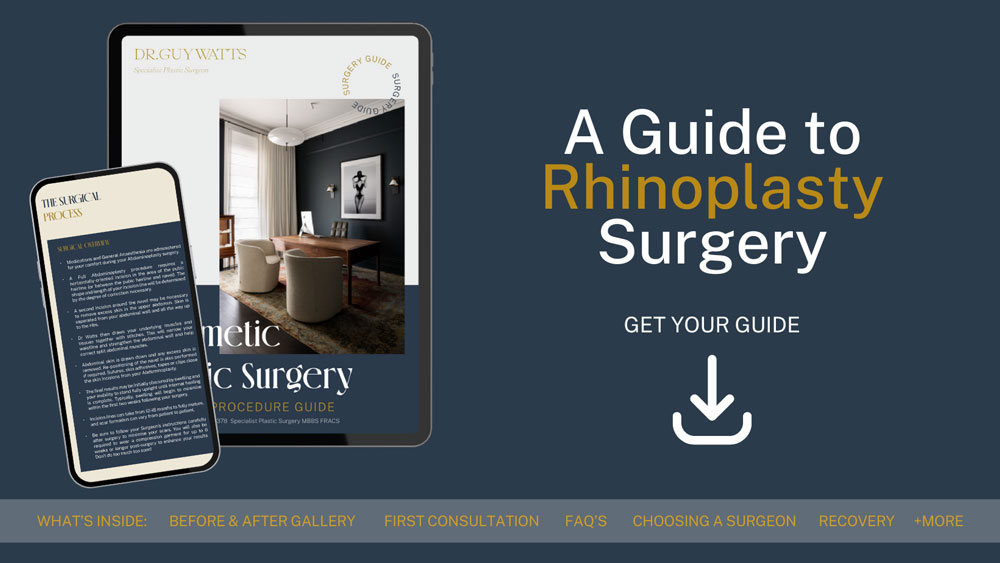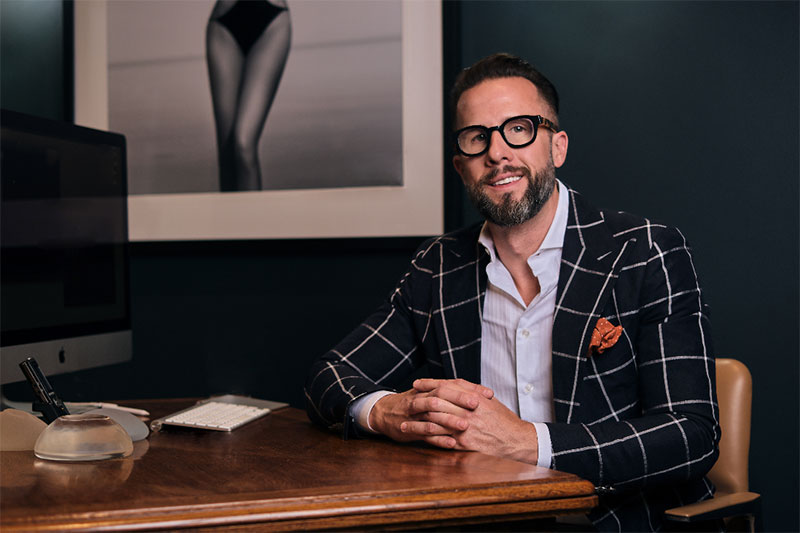
13 Aug What is a Dorsal Hump?
Causes and Options for a Dorsal Hump
If you’ve ever looked in the mirror and noticed a prominent bump on the bridge of your nose, you may have what is known as a dorsal hump. In this blog post, Specialist Plastic Surgeon Dr. Guy Watts will offer more details about dorsal humps, exploring their causes, characteristics, and the various options available to alleviate them.
Take our quiz, and find out if you are ready for surgery
What is a Dorsal Hump?
A dorsal hump, also known as a nasal hump or a nasal dorsum hump, is a raised area of bone and/or cartilage along the bridge of the nose. This bump can vary in size and shape, ranging from a slight curvature to a more pronounced protrusion. Dorsal humps can affect both men and women and are often a result of various factors, including genetics, trauma and the ageing process.
Identifying a Dorsal Hump
When examining your nose, you may notice a dorsal hump if there is a visible bump or ridge along the nasal bridge. This hump can be seen from the side profile and may appear more prominent in certain lighting conditions. Some people may find that their dorsal hump is more noticeable when they smile, as the muscles in the face can accentuate the appearance of the bump.
If you suspect you have a dorsal hump and are considering treatment options, it’s important to consult with Dr. Watts. During your consultation, Dr. Watts will examine your nose and assess the severity of your dorsal hump.
Causes of Dorsal Humps
Genetic Predisposition
One causes of dorsal humps is genetic predisposition. If one or both of your parents have a prominent nasal bump, you may be more likely to develop a dorsal hump yourself. This is because the shape and structure of your nose are largely determined by the genes you inherit from your family.
Family History
Take a look at your family members, particularly your parents and siblings. If you notice that several of them have dorsal humps, it’s a strong indication that genetics may be playing a role in your own nasal structure. Understanding your family history can help you and Dr. Watts determine the right course of action for you when it comes to treating your dorsal hump.
Ethnic Variations
Dorsal humps are more prevalent in certain ethnic groups, such as those of Middle Eastern, Mediterranean, or African descent. This is due to the unique facial characteristics associated with these ethnicities, which often include a more prominent nasal bridge.
Trauma and Injury
- Accidental Trauma: In some cases, a dorsal hump may develop as a result of accidental trauma to the nose. This can occur due to a fall, a car accident, or any other incident that causes a direct impact to the nasal area. When the nose is fractured or the cartilage is damaged, it can lead to the formation of a bump along the nasal bridge as the tissues heal.
- Sports Injuries: Athletes, particularly those who participate in contact sports like football, hockey, or boxing, are at a higher risk of developing a dorsal hump due to sports-related injuries. Wearing protective gear, such as a helmet with a face mask, can help reduce the risk of nasal trauma during sports activities.
- Surgical Trauma: In rare cases, a dorsal hump may be an unintended consequence of previous nasal surgery. If too much cartilage or bone is removed during a rhinoplasty procedure, it can cause the nasal bridge to collapse, resulting in a visible hump.
The Ageing Process
- Changes in Nasal Structure: As we age, our facial features undergo changes, and the nose is no exception. Over time, the cartilage and bone structure of the nose can shift, which can result in the development of a dorsal hump. This is particularly true for individuals who have a genetic predisposition to nasal bumps or those who have experienced nasal trauma in the past.
- Effects of Skin Elasticity Loss: In addition to changes in the underlying nasal structure, the ageing process also causes a loss of skin elasticity. As the skin loses its ability to snap back into place, it can begin to loosen and drape over the nasal bump, making the dorsal hump appear more pronounced. This is why many people seek out treatment options for their dorsal humps as they enter their 40s, 50s, and beyond.
DOWNLOAD DR WATTS’ ULTIMAGE GUIDE TO RHINOPLASTY

Non-Surgical Options for Dorsal Hump
Dermal Fillers
For those who prefer a non-surgical approach to treating the dorsal hump, volumising treatments may be an option. These treatments can be used to help smooth out the appearance of a nasal bump by filling in the areas around the hump.
It’s important to note that volumising treatments are temporary, typically lasting between 6 to 18 months, depending on the type of treatment used and your individual response to the treatment. You will need to undergo touch-up treatments to maintain your results over time.
Surgical Options – Rhinoplasty
For those seeking a more permanent change to their dorsal hump, rhinoplasty, or nose reshaping surgery, may be a suitable option. Rhinoplasty is a surgical procedure that aims to alter the appearance and/or function of the nose by changing its shape, size, and structure. When it comes to treating a dorsal hump, rhinoplasty can involve the removal of excess bone and cartilage, as well as the repositioning of nasal tissues to make the nasal bridge smoother and more balanced.
Types of Rhinoplasty Procedures for Dorsal Hump
Closed Rhinoplasty
Procedure Details
Closed rhinoplasty, also known as endonasal rhinoplasty, is a surgical technique in which all incisions are made inside the nostrils. This approach allows Dr. Watts to access the nasal framework without leaving any visible scars on the external skin of the nose. During a closed rhinoplasty for dorsal hump removal, Dr. Watts will make small incisions inside your nostrils to expose the underlying bone and cartilage. He will then use specific tools to file down or remove the excess tissue. In some cases, Dr. Watts may also need to perform osteotomies, which involves making precise cuts in the nasal bones to reposition them and achieve the shape required.
Recovery Process
After a closed rhinoplasty, you can expect some swelling, bruising, and discomfort in the nasal area. Dr. Watts will provide you with detailed post-operative instructions, which may include the use of cold compresses, pain medication, and nasal packing to support the new shape of your nose. Most patients can return to work and other non-strenuous activities within 7 to 10 days following their closed rhinoplasty. However, it’s important to avoid any activities that could cause impact to your nose, such as contact sports, for at least 6 weeks to allow your nose to heal properly.
Pros and Cons
The main advantage of closed rhinoplasty is that it does not leave any visible scars on the external skin of the nose. This can be a good option for patients who are concerned about the appearance of surgical scars or who have a history of poor scarring. However, closed rhinoplasty can be more technically challenging for surgeons, as it offers a more limited view of the nasal structures compared to open rhinoplasty. This may result in a less precise reshaping of the dorsal hump and a higher risk of asymmetry or other complications.
Open Rhinoplasty
Procedure Details
Open rhinoplasty, also known as external rhinoplasty, is a surgical technique that involves making a small incision across the columella, the strip of skin that separates the nostrils. This incision allows Dr. Watts to lift the skin of the nose and gain direct access to the underlying bone and cartilage. During an open rhinoplasty for dorsal hump removal, Dr. Watts will separate the skin from the nasal framework, providing a clear view of the structures that need to be altered. They will then use different techniques including filing, rasping, and excision to remove the excess bone and cartilage that make up your dorsal hump. If necessary, Dr. Watts may also perform osteotomies to reposition the nasal bones and achieve the required shape.
Recovery Process
The recovery process for open rhinoplasty is similar to that of closed rhinoplasty, with most patients experiencing swelling, bruising, and discomfort in the days following their procedure. Dr. Watts will provide you with detailed post-operative instructions to help manage these side effects and optimise the healing process. Patients can typically return to work and other non-strenuous activities within 7 to 14 days after an open rhinoplasty. However, it’s important to avoid any activities that could cause impact to your nose for at least 6 weeks to allow your nose to heal properly and to prevent any complications.
Pros and Cons
The main advantage of open rhinoplasty is that it provides surgeons with a increased view of the nasal structures, allowing for more precise reshaping of the dorsal hump and other nasal features. This can lead to more predictable results and a lower risk of asymmetry or other complications. However, open rhinoplasty does leave a small scar on the columella, which may be visible in some patients. While this scar typically fades over time and becomes less noticeable, it may be a concern for some individuals who are considering the procedure.
FAQs about Dorsal Hump
Can a dorsal hump affect my breathing?
- In most cases, a dorsal hump is a cosmetic concern and does not affect breathing. However, if the hump is caused by a deviated septum or other structural abnormalities, it may contribute to breathing difficulties.
- A thorough evaluation by a qualified plastic surgeon or otolaryngologist can help determine if your dorsal hump is impacting your nasal function.
Is there a non-surgical way to permanently reduce the appearance of a dorsal hump?
- Currently, there are no non-surgical treatments that can permanently reduce or eliminate a dorsal hump.
- Non-surgical options, such as volumising treatments can temporarily mask the appearance of a hump by adding volume to the surrounding areas, but these treatments do not address the underlying bone and cartilage structure.
At what age can I consider rhinoplasty for my dorsal hump?
- Rhinoplasty for dorsal hump removal is typically recommended for patients who have finished their facial growth and development. For girls, this usually occurs around age 15 or 16, while for boys, it may be a bit later, around age 16 or 17.
- It’s important to consult with a plastic surgeon with extensive experience in facial features to determine if you are a good candidate for the procedure based on your individual anatomy and maturity.
Will my insurance cover rhinoplasty for dorsal hump removal?
- In most cases, insurance will not cover rhinoplasty for dorsal hump removal, as it is considered a cosmetic procedure. However, if your dorsal hump is causing significant breathing problems or is the result of a documented injury, your insurance provider may cover a portion of the surgery.
- Check with your insurance company and discuss your specific case with Dr. Watts.
How long does it take to see the final results after rhinoplasty for dorsal hump removal?
- While you will notice an immediate change in the appearance of your nose after surgery, it can take up to a year for the final results to be fully apparent. This is because the swelling in your nose will gradually subside over the months following your procedure, and the skin and soft tissues will adapt to the new underlying structure. Be patient and follow Dr. Watts’ post-operative instructions to optimise results.
Further Reading about Rhinoplasty with Perth Specialist Plastic Surgeon Dr. Guy Watts
- Read more about Turkish Rhinoplasty
- Read more about Nose Shapes and the Different Types
- Read more about Top 5 ways to alter your nose
- Read more about What is a Deviated Septum?
Medical References about Dorsal Hump
About Dr. Guy Watts – MED0001539378
FRACS (Plas) – Specialist Plastic Surgeon In Perth WA
Dr. Guy Watts is a Specialist Plastic Surgeon (AHPRA MED0001539378) with an extensive career that spans across renowned plastic surgery clinics worldwide. His experience has been honed through invaluable experiences at esteemed establishments such as the New York Eye and Ear Infirmary and the renowned Pitanguy Clinic in Brazil.
Having collaborated with the foremost cosmetic plastic surgeons on a global scale, Dr. Watts has chosen to return to Perth after a 17-year journey of intensive training and invaluable professional experience to bring the latest practices and technology in cosmetic plastic surgery to his patients.
Dr. Watts is a Fellow of the Royal Australasian College of Surgeons (FRACS) and a Member of the Australian Society of Plastic Surgeons (ASPS), Australasian Society of Aesthetic Plastic Surgeons (ASAPS) and the International Society of Aesthetic Plastic Surgeons (ISAPS).
Read about the potential Risks and Complications of Surgery
Read the Patient Information and Resources
About CLINISPA
Clinispa is Dr Watts’ bespoke medical clinic performing Cosmetic Aesthetic treatments. At Clinispa, we offer advanced clinical treatments in a luxurious and calming environment, tailored to support your skin’s health and appearance.
Clinispa aesthetic services are performed by Dr Guy Watts’ nursing professionals, who have a passion for and solid understanding of facial aesthetics.
All Clinispa clients are considered individually, with a personalised treatment plan consisting of advanced scientific approaches to cosmetic aesthetics. We incorporate innovative technologies in conjunction with superiorly formulated skin care.
For more information about the full range of Clinispa Aesthetic of Cosmetic Treatments visit the Clinispa website








Sorry, the comment form is closed at this time.